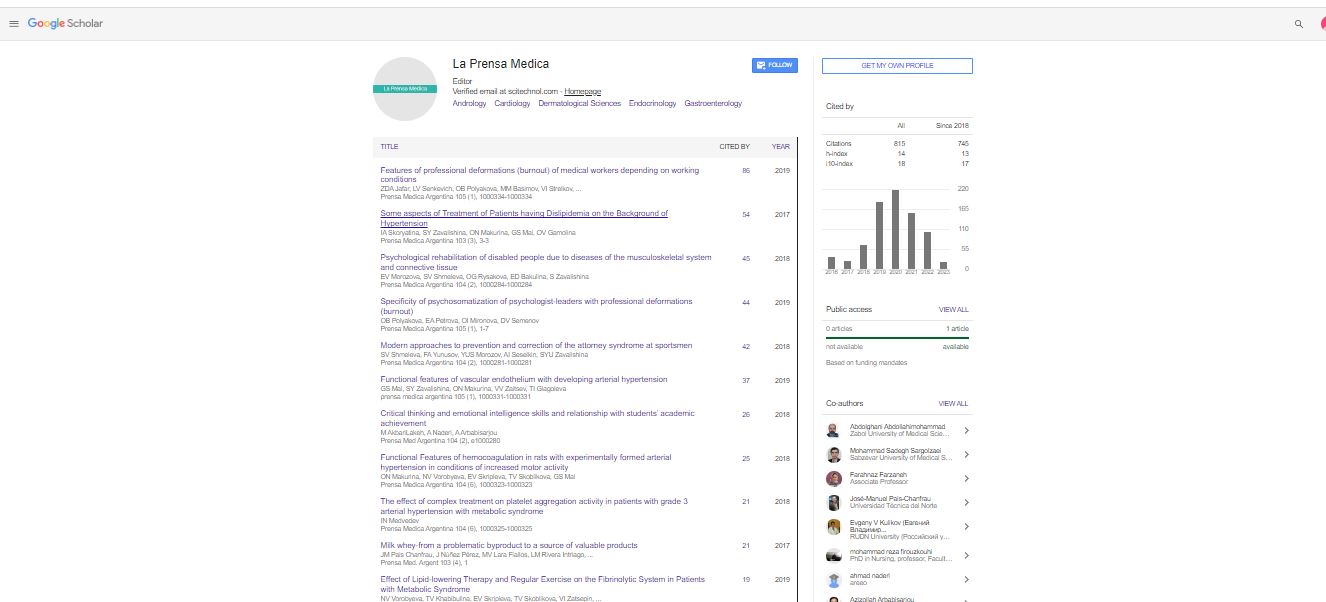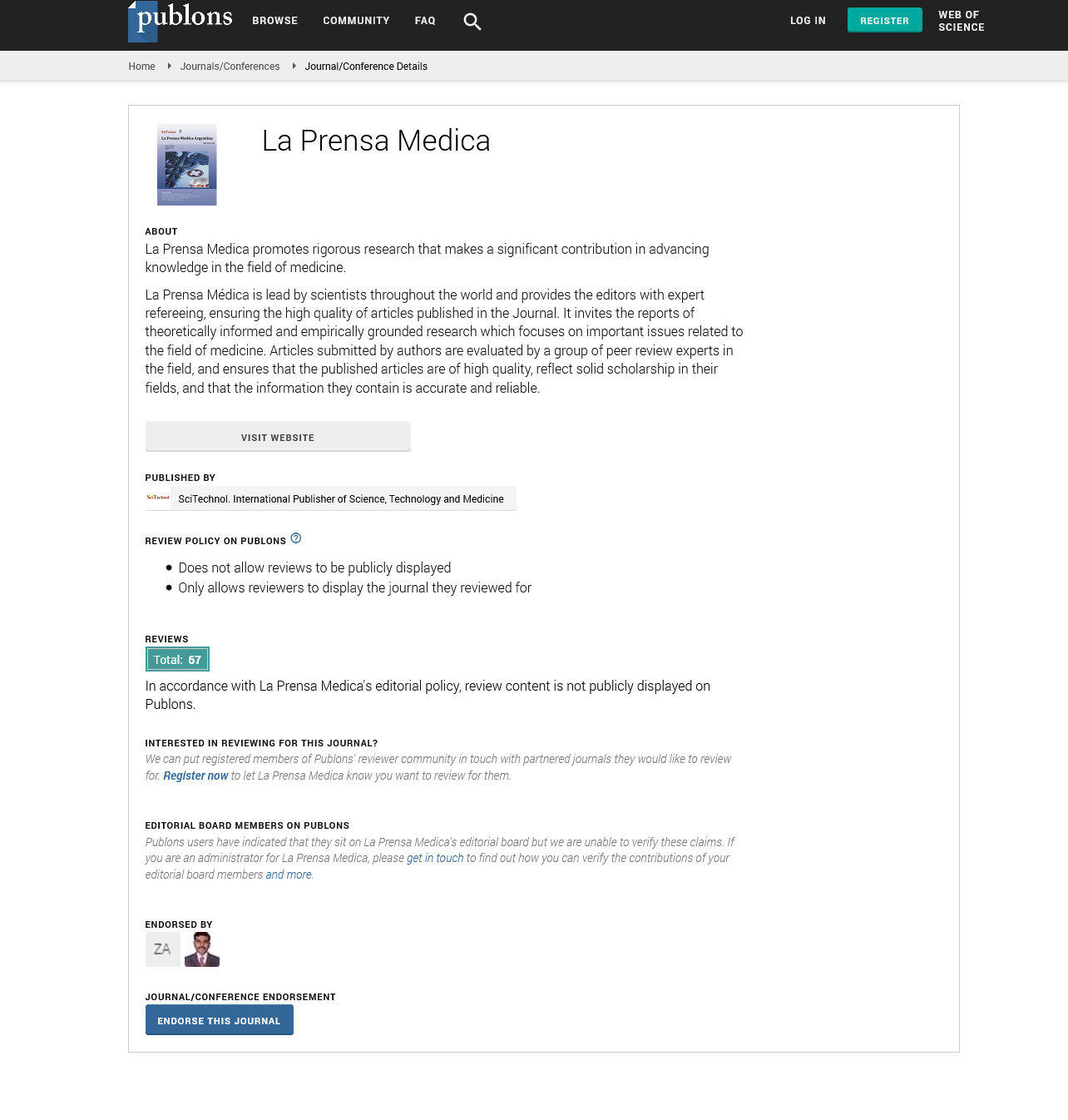Perspective, La Prensa Medica Vol: 109 Issue: 2
Redefining the Landscape of Ocular Neovascularization: Recent Advances and Promising Perspectives
Wenan Yuan Zhu*
1Department of Ophthalmology, Beijing Liangxiang Hospital, Beijing, China
*Corresponding Author: Wenan Yuan Zhu,
Department of Ophthalmology,
Beijing Liangxiang Hospital, Beijing, China
E-mail: zhunan@163.com
Received date: 25 April, 2023, Manuscript No. LPMA-23-102734;
Editor assigned date: 27 April, 2023, PreQC No. LPMA-23-102734 (PQ);
Reviewed date: 12 May, 2023, QC No. LPMA-23-102734;
Revised date: 19 May, 2023, Manuscript No. LPMA-23-102734 (R);
Published date: 26 May, 2023, DOI: 10.4172/0032-745X.1000160
Citation: Zhu WY (2023) Redefining the Landscape of Ocular Neovascularization: Recent Advances and Promising Perspectives. La Prensa Medica 109:2.
Abstract
Description
Ocular neovascularization is a pathological process characterized by the abnormal growth of new blood vessels in the eye, specifically in the retina or other ocular structures. It is a common feature of various sight-threatening conditions, including Age-related Macular Degeneration (AMD), diabetic retinopathy, and retinal vein occlusion. Left untreated, ocular neovascularization can lead to vision loss and severe complications. Effective management of this condition requires a multidisciplinary approach, including timely diagnosis, targeted therapeutic interventions, and continuous monitoring. This study aims to provide an in-depth analysis of ocular neovascularization, focusing on the current drug of choice and recent advancements in its treatment.
Ocular neovascularization involves complex molecular and cellular processes. In response to hypoxia and inflammatory stimuli, angiogenic factors, such as Vascular Endothelial Growth Factor (VEGF), are upregulated, triggering the formation of new blood vessels. Abnormal angiogenesis disrupts the delicate balance between pro-angiogenic and anti-angiogenic factors, leading to uncontrolled vessel growth. The resulting neovascularization can cause structural and functional damage to the affected ocular tissues. The advent of anti-VEGF therapy revolutionized the management of ocular neovascularization. Drugs such as ranibizumab, bevacizumab, and aflibercept are monoclonal antibodies that specifically target and neutralize VEGF, inhibiting its angiogenic effects.
These agents are administered via intravitreal injections and have demonstrated significant efficacy in reducing neovascularization, improving visual acuity, and stabilizing or reversing disease progression in various ocular conditions. Anti-VEGF therapy has become the cornerstone of treatment for ocular neovascularization. Recent studies have explored the efficacy and safety of extending the dosing intervals between anti-VEGF injections. Treat-and-extend regimens, in which the interval between injections is gradually increased based on individual patient response, have shown promise in maintaining disease control while reducing the burden of frequent clinic visits. Researchers have investigated the potential benefits of combining anti-VEGF therapy with other modalities to enhance treatment outcomes. Combinations of anti-VEGF agents with corticosteroids, photodynamic therapy, or laser photocoagulation have been explored, aiming to target different aspects of neovascularization and provide synergistic effects.
The development of new anti-VEGF agents with improved pharmacokinetic properties and extended duration of action is an area of active research. Biologic agents with longer half-lives, such as brolucizumab and abicipar pegol, have shown efficacy in clinical trials and may reduce the treatment burden for patients. Gene therapy approaches for ocular neovascularization are being explored, focusing on inhibiting VEGF expression or enhancing the expression of antiangiogenic factors. Techniques such as RNA interference and viral vectors have shown promise in preclinical and early clinical trials, offering potential long-term and targeted treatment options. Researchers are investigating alternative targets and pathways involved in ocular neovascularization. Agents targeting other angiogenic factors, such as Platelet-Derived Growth Factor (PDGF) or Fibroblast Growth Factor (FGF), are being explored as potential adjunctive therapies or alternatives to anti-VEGF agents.
Conclusion
Ocular neovascularization is a complex pathological process that requires targeted and timely interventions to prevent vision loss and complications. Anti-VEGF therapy has revolutionized the treatment landscape, offering significant benefits in managing neovascular ocular diseases. Recent advancements, including extended dosing regimens, combination therapies, novel anti-VEGF agents, gene therapy, and exploration of alternative targets, show promise for further improving treatment outcomes. Continued research, clinical trials, and collaborative efforts among researchers, clinicians, and pharmaceutical industries are essential to optimizing the management of ocular neovascularization and enhancing visual outcomes for affected individuals.
 Spanish
Spanish  Chinese
Chinese  Russian
Russian  German
German  French
French  Japanese
Japanese  Portuguese
Portuguese  Hindi
Hindi 

